The Martian Movie And Our Real Journey To Mars
The Martian Movie and Our Real Journey to Mars
The Martian movie is set 20 years in the future, but here at NASA we are already developing many of the technologies that appear in the film. The movie takes the work we’re doing and extends it into fiction set in the 2030s, when NASA astronauts are regularly traveling to Mars and living on the surface. Here are a few ways The Martian movie compares to what we’re really doing on our journey to Mars:
Analog Missions

MOVIE: In the film, Astronaut Mark Watney is stranded on the Red Planet.
REALITY: In preparation for sending humans to Mars, we have completed one of the most extensive isolation missions in Hawaii, known as HI-SEAS. The goal of this study was to see how isolation and the lack of privacy in a small group affects social aspects of would-be explorers. The most recent simulation was eight months long, and the next mission is planned to last a year.
Spaceport

MOVIE: The Martian movie launches astronauts on the Aries missions from a refurbished and state of the art space center.
REALITY: Currently, the Ground Systems Development and Operations’ primary objective is to prepare the center to process and launch the next-generation vehicles and spacecraft designed to achieve our goals for space exploration. We are not only working to develop new systems, but also refurbishing and upgrading infrastructure to meet future demands.
Deep Space Propulsion

MOVIE: In the film, the astronauts depart the Red Planet using a propulsion system know as the Mars Ascent Vehicle (MAV).
REALITY: We are currently developing the most powerful rocket we’ve ever built, our Space Launch System (SLS). Once complete, this system will enable astronauts to travel deeper into the solar system than ever before! The RS-25 engines that will be used on the SLS, were previously utilized as the main engine on our space shuttles. These engines have proven their reliability and are currently being refurbished with updated and improved technology for our journey to Mars.
Mission Control

MOVIE: In the movie, Mission Control operations support the Aries 3 crew.
REALITY: On our real journey to Mars, Mission Control in Houston will support our Orion spacecraft and the crew onboard as they travel into deep space.
Habitat

MOVIE: The artificial living habitat on Mars in The Martian movie is constructed of industrial canvas and contains an array of life support systems.
REALITY: The Human Exploration Research Analog (HERA), formerly known as the Deep Space Habitat, is a three-story module that was designed and created through a series of university competitions. Studies conducted in habitat mockups will allow us to evolve this technology to create a reliable structures for use on Mars.
Rover

MOVIE: The characters in the film are able to cruise around the Red Planet inside the Mars Decent Vehicle (MDV).
REALITY: We are currently developing a next generation vehicle for space exploration. Our Mars Exploration Vehicle (MEV) is designed to be flexible depending on the destination. It will have a pressurized cabin, ability to house two astronauts for up to 14 days and will be about the size of a pickup truck.
Harvest

MOVIE: Astronaut Mark Watney grows potatoes on Mars in The Martian movie.
REALITY: We’re already growing and harvesting lettuce on the International Space Station in preparation for deep space exploration. Growing fresh food in space will provide future pioneers with a sustainable food supplement, and could also be used for recreational gardening during deep space missions.
Spacesuit

MOVIE: The spacesuit worn by astronauts in the film allows them to work and function on the surface of Mars, while protecting them from the harsh environment.
REALITY: Prototypes of our Z-2 Exploration Suit are helping to develop the technologies astronauts will use to live and work on the the Martian surface. Technology advances in this next generation spacesuit would shorten preparation time, improve safety and boost astronaut capabilities during spacewalks and surface activities.
More Posts from Inter-stellxr-blog and Others
How you look at color is about to get all messed up…
A while back, I asked you to describe what color the moon appears to your eye. I got some pretty varied and entertaining answers, but you overwhelmingly agreed: The moon is essentially white or bright silver.
Well, you’re wrong.
The moon’s not white at all. It’s actually closer in color to an asphalt road, as we can clearly see in this 100% actually real series of images taken of the moon transiting Earth, courtesy of NOAA’s DSCOVR satellite:

That whole “the moon is white” thing? It’s just a nasty trick played on your brain by … well, another part of your brain. It has to do with the fact that our eyes perceive illumination in a scene relatively, not absolutely. It’s also why this GIF breaks your brain a little:

Watch this week’s It’s Okay To Be Smart video above to find out more!
Bonus: The PBS Digital Studios Science Squad™ brings you a double whammy of perceptual illusions this week! White isn’t the only light that messes with your visual system, not by a long shot. Did you know that red + green can look like… yellow?

Check out the video below from The Physics Girl and let Dianna teach you why, when it comes to colors, you should never quite believe your eyes:

Very true.


New Horizons captures images of water ice and blue skies on Pluto
New Horizons, the spacecraft that keeps on giving.

October 13, 1966 – Gemini 12 astronaut Buzz Aldrin undergoes zero-gravity training aboard an Air Force KC-135 vomit comet. (NASA)

Check out Fingerprints of Water on the Sand via NASA http://ift.tt/1Mxtpaz

A researcher in Russia has made more than 48 million journal articles - almost every single peer-reviewed paper every published - freely available online. And she’s now refusing to shut the site down, despite a court injunction and a lawsuit from Elsevier, one of the world’s biggest publishers.
For those of you who aren’t already using it, the site in question is Sci-Hub, and it’s sort of like a Pirate Bay of the science world. It was established in 2011 by neuroscientist Alexandra Elbakyan, who was frustrated that she couldn’t afford to access the articles needed for her research, and it’s since gone viral, with hundreds of thousands of papers being downloaded daily. But at the end of last year, the site was ordered to be taken down by a New York district court - a ruling that Elbakyan has decided to fight, triggering a debate over who really owns science.
“Payment of $32 is just insane when you need to skim or read tens or hundreds of these papers to do research. I obtained these papers by pirating them,”Elbakyan told Torrent Freak last year. “Everyone should have access to knowledge regardless of their income or affiliation. And that’s absolutely legal.”
If it sounds like a modern day Robin Hood struggle, that’s because it kinda is. But in this story, it’s not just the poor who don’t have access to scientific papers - journal subscriptions have become so expensive that leading universities such as Harvard and Cornell have admitted they can no longer afford them. Researchers have also taken a stand - with 15,000 scientists vowing to boycott publisher Elsevier in part for its excessive paywall fees.
Continue Reading.


Hubble’s Jupiter Maps Reveals Weird Structures
Over a 10 hour period, the Hubble Space Telescope gazed at the solar system’s largest planet to produce one of the most spectacular maps of Jupiter’s complex and dynamic atmosphere. Immediately astronomers were able to measure the size of the planet’s shrinking Great Red Spot and notice some mysterious structures along the way.
As the spot has shrunk, it’s color has also become more anemic, losing some of its redness. Also, as these new Hubble observations show, a strange wispy structure has formed inside the storm, becoming warped by the high-speed winds that have been clocked at a speed of 540 kilometers (335 miles) per hour. Astronomers, so far, have little explanation as to what this feature is or what caused it.
Another oddity has been spied just north of the planet’s equator — a wave-like structure has formed, something that hasn’t been seen since the Voyager 2 flyby in 1979. During that flyby, these waves were assumed to be a transient event and the fact the spacecraft imaged them was a fluke. But they’ve now returned, no doubt sparking some huge interest as to their origins.
Click to learn more
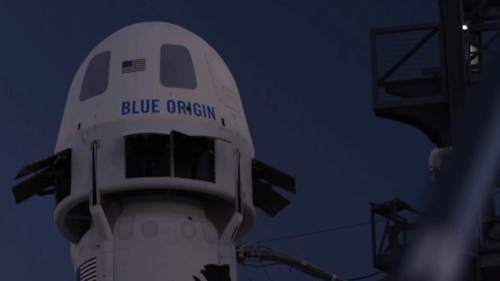
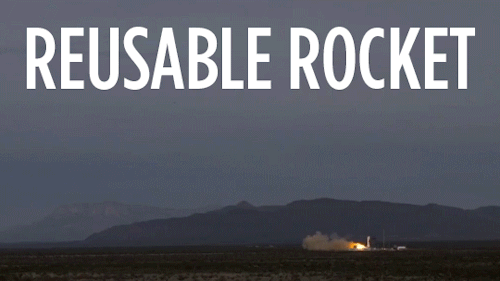

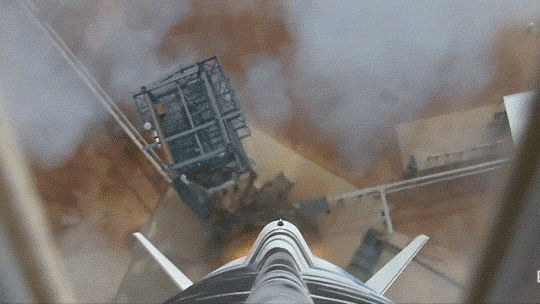
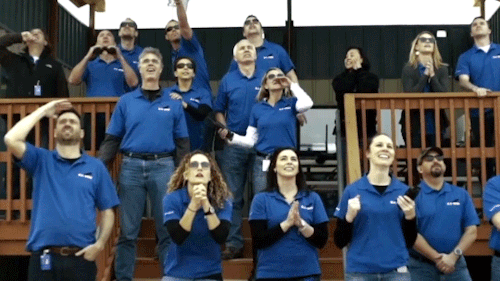
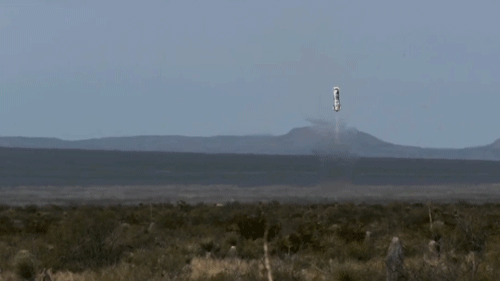

Via his very first tweet, Jeff Bezos announced that his spaceflight company has accomplished a historic first. It sent a rocket to the edge of space and then landed that rocket’s main fuselage gently on dry land.
Most things humans have sent into space are pushed up there by a disposable rocket. Once the rockets do their job, they fall back to earth, usually worse for wear. They have to be rebuilt each time (though sometimes their parts can be reused). That’s an expensive process, especially if you are a private company hoping to bring tourists to space. Virgin Atlantic, Elon Musk’s company SpaceX and Bezos’ Blue Origin all want to do just that.
And now Blue Origin has paved the way, landing its rocket on its second attempt (the propulsion module was destroyed when they first tried). Here’s the video in full:
Elon Musk responded to the news on Twitter. He pointed out that it requires much greater speed to actually reach orbit than it does to reach the edge of space. (Phil Plait has some good analysis of the exchange over on his Bad Astronomy blog.)
Still, it’s a pretty amazing accomplishment.





This is me
i dab every morning when i wake up
-
 round-hatches-are-terrifying reblogged this · 9 months ago
round-hatches-are-terrifying reblogged this · 9 months ago -
 round-hatches-are-terrifying liked this · 9 months ago
round-hatches-are-terrifying liked this · 9 months ago -
 littlealexcub reblogged this · 10 months ago
littlealexcub reblogged this · 10 months ago -
 lockedndenied liked this · 1 year ago
lockedndenied liked this · 1 year ago -
 rmarts liked this · 1 year ago
rmarts liked this · 1 year ago -
 simpforsebastianstan06 liked this · 3 years ago
simpforsebastianstan06 liked this · 3 years ago -
 kaseysgirl86-blog liked this · 5 years ago
kaseysgirl86-blog liked this · 5 years ago -
 luminoussphereofplasma reblogged this · 6 years ago
luminoussphereofplasma reblogged this · 6 years ago -
 cityhorizons liked this · 6 years ago
cityhorizons liked this · 6 years ago -
 lemon-sodapaws liked this · 6 years ago
lemon-sodapaws liked this · 6 years ago -
 cutekirk reblogged this · 6 years ago
cutekirk reblogged this · 6 years ago -
 carielle6 reblogged this · 6 years ago
carielle6 reblogged this · 6 years ago -
 jarmilatblr liked this · 6 years ago
jarmilatblr liked this · 6 years ago -
 dazzlingdianavera liked this · 6 years ago
dazzlingdianavera liked this · 6 years ago -
 itsdragonfire13 liked this · 7 years ago
itsdragonfire13 liked this · 7 years ago -
 moonnightlight liked this · 7 years ago
moonnightlight liked this · 7 years ago -
 rhaenyratargaryendefender liked this · 7 years ago
rhaenyratargaryendefender liked this · 7 years ago -
 callmoiwhatuwant reblogged this · 7 years ago
callmoiwhatuwant reblogged this · 7 years ago -
 starfaringships reblogged this · 7 years ago
starfaringships reblogged this · 7 years ago -
 testingroundforstuff reblogged this · 7 years ago
testingroundforstuff reblogged this · 7 years ago -
 og-swanky liked this · 7 years ago
og-swanky liked this · 7 years ago -
 trigrerhiden liked this · 7 years ago
trigrerhiden liked this · 7 years ago -
 myceliumnb liked this · 7 years ago
myceliumnb liked this · 7 years ago -
 kagemushakosuke reblogged this · 7 years ago
kagemushakosuke reblogged this · 7 years ago -
 kagemushakosuke liked this · 7 years ago
kagemushakosuke liked this · 7 years ago -
 awesomeman281 liked this · 7 years ago
awesomeman281 liked this · 7 years ago
"I don't know who will read this. I guess someone will find it eventually. Maybe in a hundred years or so." -Mark Watney
174 posts